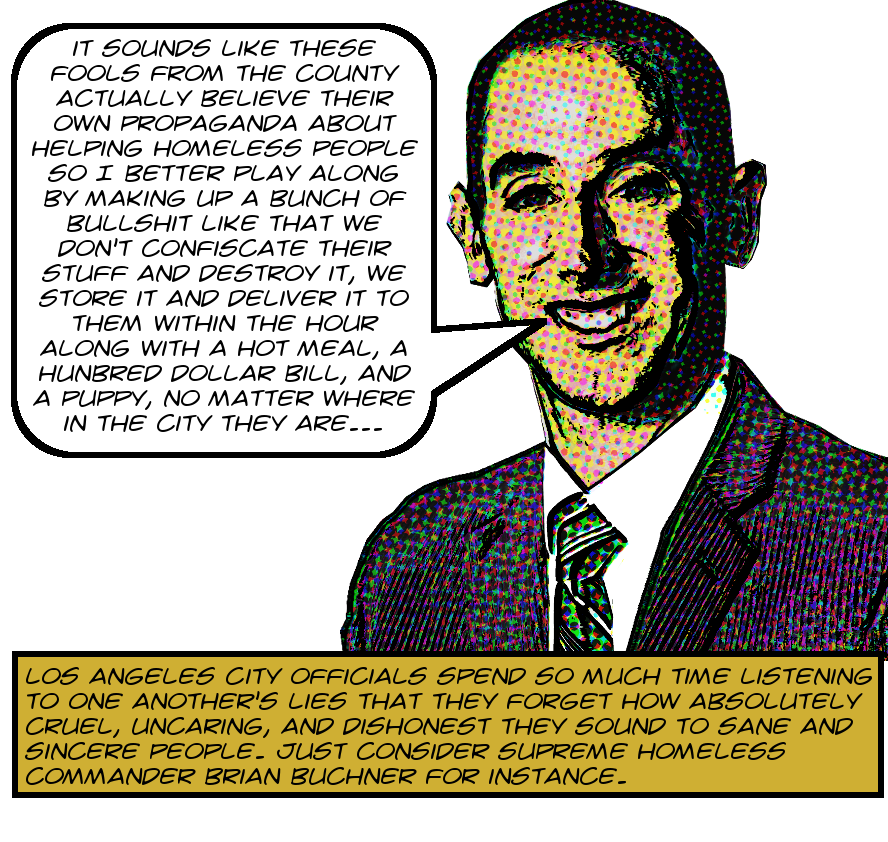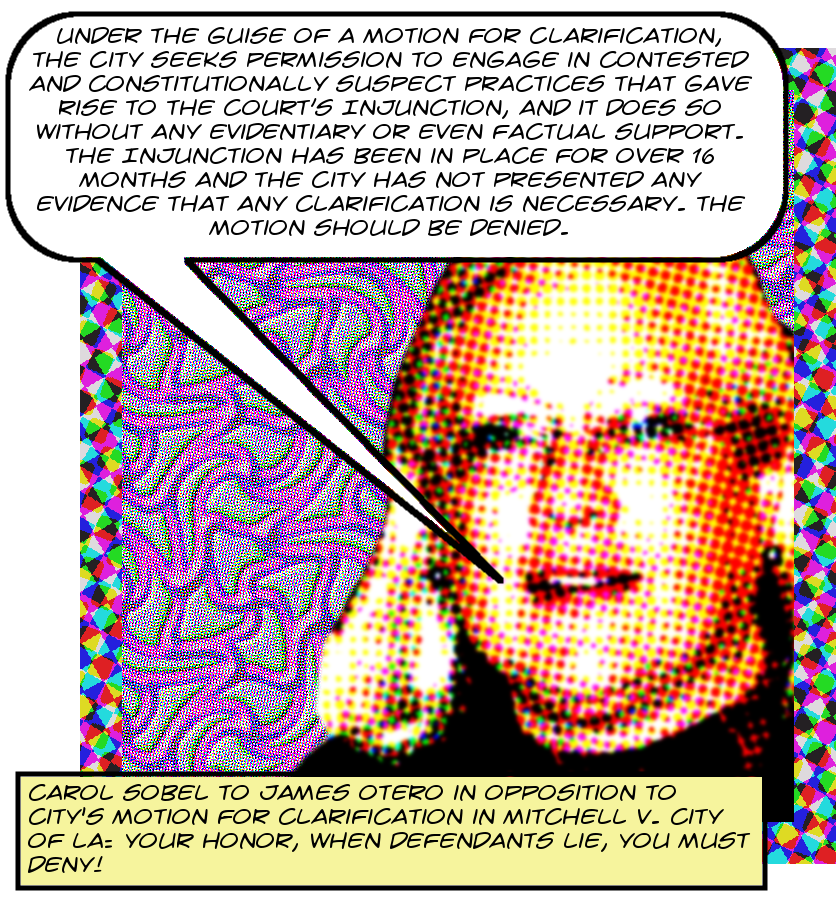 The City of Los Angeles is well-known for its particularly cruel policies towards homeless people living in encampments. City workers confiscate and destroy essential property like medicine and legal papers. They pointlessly force people to move by breaking up their encampments without offering alternatives, and so on. The City has been sued often and sued successfully many times for these practices, and they will be sued again and again and again.
The City of Los Angeles is well-known for its particularly cruel policies towards homeless people living in encampments. City workers confiscate and destroy essential property like medicine and legal papers. They pointlessly force people to move by breaking up their encampments without offering alternatives, and so on. The City has been sued often and sued successfully many times for these practices, and they will be sued again and again and again.
And as immersed as I am in municipal politics, it’s easy to forget that there are many, many other local jurisdictions dealing with homelessness, even within the City of Los Angeles itself. There’s CalTrans, Metro, the County, and of course any number of other cities and authorities. And sometimes they have to work together for various reasons, like property administered by one agency that’s within the boundaries of another, and so on.
Last year the City created the Unified Homeless Response Center to implement its policies. The head of the UHRC is Brian Buchner, who’s some kind of staffer in Eric Garcetti’s office. And the other major departments involved with homelessness also have people assigned to the UHRC as well. For instance, LAPD’s Emada Tingirides and others. And I recently obtained a huge set of emails between Buchner and Tingirides, along with attachments.
This material is available here on Archive.Org. It’s already proving invaluable in understanding UHRC policies and procedures as well as the software tools they’re using in their responses to homelessness. It is an incredibly rich, incredibly complex set of stuff and I’m going to be analyzing and writing about this material for quite a while, but today’s post is based on a tiny fragment, which is this email conversation between Buchner and Michael Castillo, who’s with the Los Angeles County Homeless Initiative.
Here’s the short version of the story, and you can find a complete transcription of the emails below. Castillo was readying his team to dismantle an encampment at Nadeau and Alameda Streets. He’s careful to say that the County does not in fact destroy encampments as a matter of policy. In fact, he says, as a matter of policy they do not:
It is not the practice of Measure H funded teams to “shuffle” our homeless neighbors from one location to another, but instead to work with them where they are.
However, this particular encampment was very close to the train tracks along Alameda and so, he says, the County decided that they had to break it up. This required the involvement of the Alameda Corridor Transit Authority, and ACTA told Castillo that this particular encampment was on property belonging to the City of Los Angeles, which meant that LAMC 56.11 would be in force.
But Castillo wasn’t having it if what he’d heard was true. He was unwilling even to participate in encampment breaking under City of LA rules:
We, myself, Lt. Deedrick, and Measure H outreach supervisors, were informed that the plan under 56.11 would call for tearing down all structures and leaving them on the site for 90 days, i.e., store them on site in the open, which we feel is somewhat inhuman and could lead to a lawsuit. Lt. Deedrick, HOST lead, and I informed the ACTA that if this is the plan Measure H funded outreach teams and the HOST cannot be on site on January 7th.
Castillo was also really worried about the absolute necessity to distinguish between personal items and trash:
In addition, Lt. Deedrick and his team have been talking to the homeless persons on site at Nadeau this week to identify personal items versus trash and they’ve taken record of said conversations. This record will allow the cleaning crew to easily separate trash from personal items on January 7th.
And this kind of concern, this refusal to participate in immoral, inhuman, and liability-inducing activities, is admirable. If no one was willing to carry out the immoral and inhuman policies of the City of Los Angeles then the City of Los Angeles wouldn’t be immoral and inhuman. The only possible reason why things are different in the County is that the County must create an atmosphere where humanity and morality are expected. The opposite is true, obviously, with the City.
And you know, Brian Buchner didn’t have a good answer for this. At least he didn’t have a good true answer. But he had a good and patently false answer, which was that not only did the City not destroy the personal property of the homeless, not only did they store it safely in secure storage, but they would deliver it back to its owner at any time whenever they needed it:
Michael, that is an incorrect understanding or interpretation of the City’s policies and procedures under LAMC 56.11. We do not store people’s property “on site in the open” under any circumstances. We have dedicated storage sites across the City where we store all impounded property. When an individual needs access to their property, we deliver it directly to them within the hour no matter where in the City they are.
And there you have it. Brian Buchner is a liar. The Unified Homeless Response Center of the City of Los Angeles is being run by a liar.1 A liar who implements the inhuman policies of his masters at 200 N. Spring Street even while he’s lying about what those policies are. That’s where this City’s homelessness policy is now. Turn the page for a complete transcription of the conversation.
Continue reading Los Angeles County Homeless Encampment Policy Is Positively Humane Compared To The City Of Los Angeles — So In December 2018 When The County Found That It Had To Work With The City On An Encampment At Nadeau And Alameda They Said That If The City Was Going To Follow Its Usual Practices With Respect To The Homeless People’s Property The County Would Not Participate — Then Brian Buchner Of The Unified Homeless Response Center Flat-Out Lied About The Nature Of City Policies — If He’s Ashamed Of The True Confiscation Policy It Is Probably Time To Change It To Something That’s Not Shameful — Not Cruel — Not Inhumane — Not Litigation Bait — If We’re Going To Be Purely Practical

